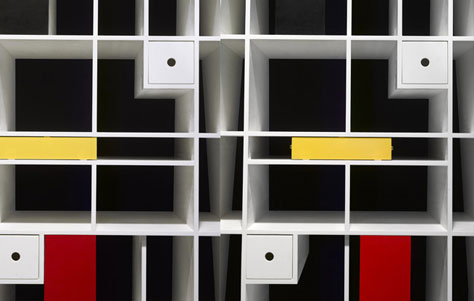Amosdesign’s Moving Mondrian
Here's an atavistic query to open this mundane Monday: what would the Bauhaus have thought of Corian? Given the movement's oft pragmatic bent-and the even oftener-invoked anthem of "form follows function," my guess is they (or most of them, anyhow) would have embraced not only it, but also similar materials like Velstone, Avonite, and Cristalplant, each created for maximum formability, durability, and hygiene.
We've mostly seen the material in a countertop capacity-albeit, in innovative incarnations like the Corian Illumination series. But who's to say the material isn't equally suited for, say, a rolling storage unit inspired by the prevailing aesthetic of the Bauhaus' Piet Mondrian?
Moving Mondrian. Designed by VladimÃr Ambroz for Amosdesign.
A Primary Use for Primary Colors
My belief is that the artist would have approved, especially given the arcane factoid that the material was first conceived as a potential substitute for human bones. Failing that development, we'll just have to depend on the creative ingenuity of designer VladimÃr Ambroz and manufacturer Amos Design, who've incorporated the versatility of Corian and the vision of Mondrian into the moving Mondrian library, a bookshelf/storage unit/cabinet on wheels with a twist, its facing elements are (inter)changeable, such that virtually any combination of primary colors may emerge among its various shelves, drawers, and movable doors.


The piece certainly shares with Mondrian's more famous works an affection for the grid, though Ambroz departs from the artist in his library's overall shape. Moving Mondrian sports a slightly trapezoidal profile, maintaining the central grid while the sides slope away slightly to facilitate a handful of niches of progressively increasing widths. The spatial variety is a nice touch. Not only does it create the various and variously-sized compartments that creative types might desire, it also establishes some visual interest of a slightly different sort. This-along with the unmistakable resemblance to the work of the great Dutch painter-makes Moving Mondrian a worthy tribute.




Leave a Reply